There are many topics that drive passion among marketers. The debate over gating vs. ungating content may be one that brings out stronger opinions.
If you peruse marketing LinkedIn, you'll see opinions across the board on this topic. Some well-respected people swear that gates are evil - others think it's unnecessary.
As a marketer myself, I asked myself ... am I missing something? Do I understand the pros-and-cons of each as much as I think I do?
And so: This article will try to avoid convincing you what to do.
Instead, the goal is that you’ll be more informed to make your own decisions and adjust your go-to-market strategies.
And a friendly reminder: content is not just a blog or webpage, but is anything a prospect / customer could consume. That’s video, podcast, infographic, embedded image, etc.
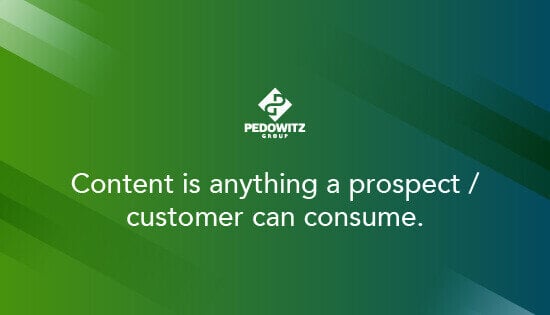
Let’s dive in, shall we?
Why gate at all? | The case for ungating | The case for gated content | What about psychology? | Identifying some myths | Healthy questions to ask | Conclusions
Why do we gate content to begin with?
This fundamental question seems silly to even ask, right?
You put up a request (typically a form of some sort) to gain a person’s information and indicated interest in a given topic, and in exchange for their email and other information, you provide content they wouldn’t be able to get anywhere else – often eBooks, PDFs, infographics, video courses, etc.
This is an overly-simplified version, but really there’s one central goal: Identify people who might eventually be good for sales activity, and hopefully, revenue.
So, a rephrasing of the title could be “is this necessary anymore?” After all, marketing out eBooks is so 2000-and-late, right? (#SorryNotSorry)
As you consider what content to leverage (if any) to ask for a prospect’s email address, keep in mind we’re discussing the concepts of each position. It’s up to you to determine if ungating everything vs. more things vs. nothing else is best for your business.
Executive summary
For those who need to bounce, here's a few of the headlines!
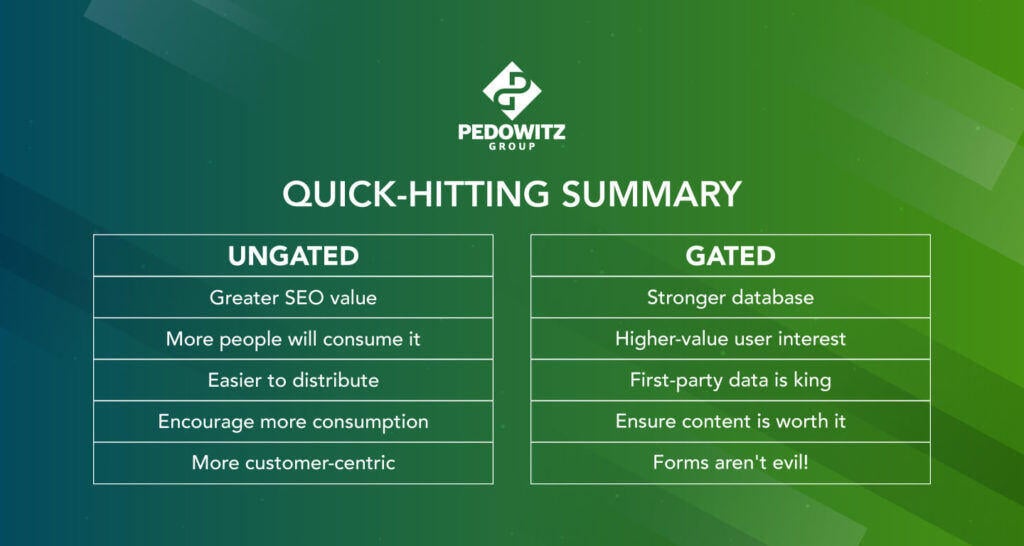
The case for ungating
Most companies have a majority of their items as ungated, but they don’t ungate all of it. And their best content is typically what’s found behind some sort of form.
So, why ungate your content?
More people can read it
Seems simple, right? But there’s more to it!
Gated content will get visitors to a page who don’t fill out the form … and thus, people who don’t read what you’ve worked hard to produce. This also can provide a negative customer experience for people who got a classic case of wrong-content-at-the-wrong-time, making them less likely to interact with you in the future.
On the flip side, ungated allows you to build your brand in a more positive light, because as prospects / customers read your content, they’ll associate positive experiences with your company name and logo. Keep pumping out authoritative content on topics your audience cares about, and they’ll start to remember your name.
That infographic, PDF, or blog with your logo stamped on it means something, and it means more in a person’s hands!
Silvio Perez over at Metadata.io provides this example to drive home the point:
“If your primary goal is to have your content consumed so you can educate and create demand within your industry then ungated is hands down mathematically superior.
Ungated: A $1,000 ad spend @ $5 cost per click, assuming a 20% consumption rate, equates to 40 people reading the content.
That's a $25 cost per consumption
Gated: A $1,000 ad spend @ $5 CPC, assuming a 10% conversion rate + a 40% consumption rate post-download, equates to 8 peope readin the content.
That's a $125 cost per consumption.
So even assuming a lower completion rate (which isn’t true) from ungated content, it’s still cheaper to get people to consume all your content - which allows you to educate the market and create demand.”
And if people aren’t signing up for a demo or booking a meeting?
“Marketing content is typically meant to educate. If people aren’t willing to say ‘call me’ then potentially we haven’t convinced the user we’re worth their time just yet, “ said Angela Earl in this podcast (7:00 mark).
SEO benefits
Gated content doesn’t help – that’s because Googlebot, which is what Google uses to learn what your content is, won’t fill out the form to grab your assets.
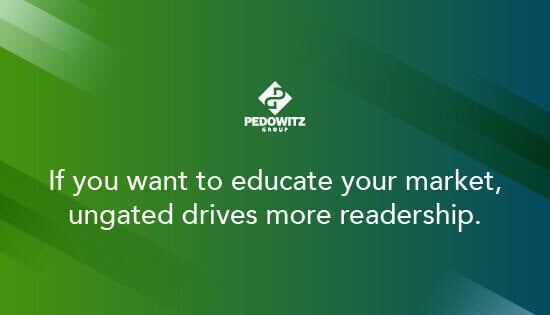
Thus, gated content won’t move the needle on helping this or other pages rank.
Ungated content can be fully-parsed by Google (and others, like Bing or Duckduckgo) and served to any user its relevant to. But it also helps other pages through internal linking and being topically related to other important content across your site.
Distribution
As folks like Ross Simmonds say often, “Create once. Distribute forever.”
Ungated content is easy to remix and get into other channels:
- Social channels
- Community forums, such as Quora, Reddit, and Medium
- Youtube videos
- Having the author add more via LinkedIn articles, personal blog, or other places they’re involved
- Paid advertising
- Email (#StillUndefeated)
Since your content is already open to the public, remixing or slicing and dicing it into other pieces makes it far more reusable because you have nothing you’re holding back.
This has an added bonus of getting your brand into places where you can't track. For instance, if a summary image from a blog of yours is shared in a marketing Reddit forum, you likely won't know - but the readers in this community will know of you!
If it takes more and more touchpoints to get a customer, ungating allows you more options to support the marketing reality of simultaneously allowing your brand and content to be in more places while embracing the reality that you can't track everything.
More complete customer story
As Nick Bennett notes, his team has used their tech stack in such a way:
“We’ve closed deals because we can see what prospects were reading on our site - and our site is entirely ungated.
For example, in one recent case (a closed-won deal) our persona map showed someone in our database with a company and exactly what they were reading. It allowed us to accelerate the opportunity way quicker than our typical deal cycle, because we could provide content related to their demonstrated pain points and focusing only on those.”
Nick Bennett, Alyce
With ungated content, you can invite a prospect to check it out for themselves and simply point them in the right direction, without the need to email over lengthy PDFs or try to get them to click a link in an email to download something.
A key consideration? Your tech stack.
Simply having intent data, if you’re lucky enough to have it, isn’t enough. You also need the right tools in place to better tie it together.
I asked Nick and Silvio what they’d recommend:
- A sales enablement tool, like Outreach or SalesLoft
- A CRM / MAP database you’re confident in. Dirty data = more anonymous website visits.
- Content tracking software, like Seismic or Highspot
- Cohesion between sales and marketing. Marketing’s looking at this data more often, but can help sales identify the right pieces to put together for more effective outreach
Build remarketing
As cookieless advertising continues to impact advertiser’s ability to provide on-point advertising, you may be thinking “isn’t this negatively impacted?”
Yes, to a degree. But that doesn’t mean you can’t remarket, right?
After all, the tracking pixels are still installed, and even with ad blocking extensions, people surf while logged into their social media all the time (and you’re being watched when that happens).
Content that’s read / visited can build your audiences, especially when they have SEO value and can be more easily distributed. This means larger paid audiences who you can serve more content to related to their demonstrated interests.
Nurture emails unneeded?
With a heavy reliance on remarketing, you can also ramp down on needing email sequences to nurture leads along to a true sales-ready lead status.
This also removes two risks:
- Unsubscribes. Unwanted email to a person who just wanted your eBook? A person may unsubscribe … cutting off people from further communications when they’re more ready to buy.
- Email privacy. As more activity is blocked (such as open rates), you’re less reliant on people clicking a link in your email to indicate interest.
It’s more customer-centric
Simply put, which does your customer want? A form, or no form?
¯\_(ツ)_/¯
The case for having gated content
If you’ve gotten this far and are prepared to rip away all of your forms, bots, etc., pump the brakes! Because there’s very good reasons to continue gating.
Let’s take a look at the pro-gate side of things:
Identify (more) higher-interest visitors
A prospect who willingly provides their contact information is obviously more interested than someone you don’t know about!
They may be in the market for a product or service you offer, or they might simply find the content interesting enough to warrant a download. Either way, you know who they are as a person.
Demand generation requires demand, and who better than people willingly saying “Hey, you have my interest?”
First-party data is (still) king. Especially with privacy concerns.
With ABM-centric approaches, sales and marketing are looking at an account in its entirety. With less-reliable cookies and a greater emphasis on user privacy, first-party data’s importance has only grown.
This means you need people’s information. And intent data can only get you so far, because while you can track what contacts are doing, that’s only if they’re matched to a record in your database.
Consider this: Your team pulls in 20 key contacts in a target account into your CRM. One of those navigates to your site through an ad or from a Google search, reads some of your content, and leaves.
Your data platforms will show an anonymous website visit unless you have some way of tying that uncookied web visit to a record in your database.
A form removes much of that concern with a market-approved way of going about it, because a prospect who grabs your content willingly volunteers that information.
Progressive profiling reduces friction
Casey Cheshire, founding of Cheshire Impact and author of Marketing Automation Unleashed: The Strategic Path For B2B Growth, says “Marketing automation allows you to use Progressive Profiling on your forms. Asking a few questions each time, building a robust profile on your leads without incurring the massive form friction everyone is talking about.”
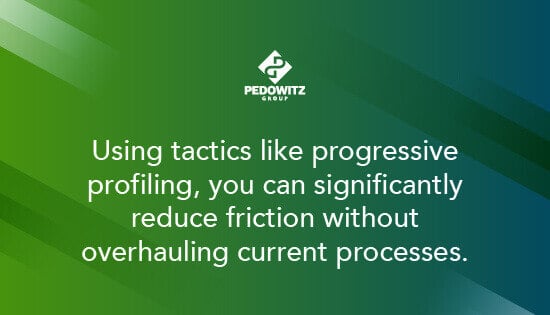
If you employ chatbots, you can do something similar using conditional logic, provided you have your mapping into your CRM or MAP in place.
Many companies can still get this wrong today, because they may ask the wrong questions … or simply ask too many of them.
The key? Ask people for information you otherwise can't get somewhere. From data providers, you can get plenty! But with one question and one information (like an email) that links a person's answer to their contact record, you can have a low-friction experience + gain additional insight into the user.
Database = More options
- Have an amazing newsletter your audience cares about?
- Want sales to know who to talk to via lead scoring?
- Desire to provide more personalized experiences with your content?
You need to know who people are. That’s your database, of course.
And you need leads in said database. Having more opportunities for people to be in that database only helps, and having content that inspires people to provide their information makes this happen more quickly.
Remember, first-party data matters. You can’t score up people from anonymized activity, which often can show up in account-level views from intent data unless you have a matched contact record from your CRM or MAP.
How’s Your Attribution?
In true revenue marketing fashion, without pipeline accountability, you’ll lose executive buy-in. No matter how your content is presented, it ultimately has to generate revenue.
- Many teams continue to measure progress with pipeline metrics such as MQLs/AQLs, SALs, SQLs, and opportunities
- And many revenue-accountable executives understand these metrics quite well.
In many companies, marketing is on the defensive for their budget. If this resonates, you need ammunition to defend your budget – and having a growing database based on marketing’s efforts is the fuel you need.
Guess what? That’s leads!
With known challenges to attribution (think terms like “dark web” and “marketing-influenced” for example), creating a true multi-touch model is challenging at best and nigh impossible at worst.
Untracked touchpoints will happen in any customer journey, for any industry. But what you can have are more on-road points that allow you to better understand the customer and what’s driving pipeline - and gated assets absolutely provide that.
Why Fix What Works?
Ross Simmonds posted some thoughts in early 2022 that ring true:
“The old way of gating content might not work as well as it did in 2018. You know... The idea of putting ALL of the value behind a form with 5 or 6 fields for your prospect to fill out. That might not work that well in a world where content has become common and most brands struggle to create content that actually differs from the market.”
Ross Simmonds, on LinkedIn
Think about it: Considering the amount of companies who do gate content, one would think that they’d stop if this didn’t work, right? What people don’t fill out are long, arduous forms that ask unnecessary information.
As Casey Cheshire said, “Forms are a barter. If they're not working then you're asking for more than you're giving. This doesn't mean remove all the forms. It means stop being selfish and create content that actually helps your buyer.”
Gated content still works. And, is it really that hard for people to fill out a field or two (especially when they can also have that autofilled by their browser)?
Here's the trick:
“The new way of gating content is giving away so much value prior to asking for a bit of information - People WANT to submit their info because they're convinced you're going to deliver more value,” says Simmonds.
This puts the onus on the company to ensure that any content that is gated is...
- Worth the price of a person’s information (which isn’t cheap, by the way)
- Value they can’t get anywhere else
- Is something they’ll actually read or use
Or as my colleague Mark Palony once said, “the value of your content is not nearly as great to your target market as it is to you.”
If you provide the value, then yes, people will still come to what you’ve built.
Does Psychology Support One vs. The Other?
As a marketer, it’s my job to understand my target audience’s preferences, interests, and thoughts. In other words, I regret not taking that Psychology 101 class in college.
My assumption as I began writing this article is that if I pay for something (in this case, my information), I’m more likely to find it valuable.
To wit:
- In 2017, researchers determined that wine tastes better if you think it costs more.
- And in this article, and experiment of people paying what they wanted showed people will typically pay something – even if they could get it for free.
- The BBC has even more research cited in this article.
In fact, as Shelle M. Santana, assistant professor at Harvard Business said, “If you can nudge people into a more communal relationship, they have a higher willingness to pay.”
But it’s not so clear-cut.
For instance, Dan Arialy found people were split between two chocolates that had a price – one offered for a penny, the other (a more expensive brand) for 26 cents.
But when each price was dropped by one cent, people overwhelmingly chose the free chocolate.
And in this Marketing Science (an academic journal) article, it’s said “people do not simply subtract costs from benefits but instead they perceive the benefits associated with free products as higher.”
The takeaway? People overvalue free stuff.
Much of this research is related to consumer products, but it’s worth remembering people who are choosing to download / read content are also consumers at heart. In fact, they’re consuming your content!
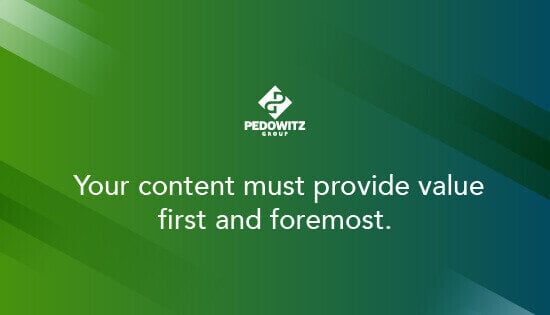
It comes back to value.
How will your target audience value the content you’re providing? And this gets to something content creators have to really think through: Are you providing something that can’t be found anywhere else?
Other questions to ask:
- If everything is free, is it really valuable?
- If the gated asset has a cost, does it become more valued since it’s different than the ungated, “free” content? Or less valued?
- Can you build a community that’s more willing to “pay” for what you’re offering?
No matter if your content is gated or ungated, you still must provide value.
But it is worth noting that if a person pays a price (their information) to read, the expectation of what “good” value is will be undoubtedly higher.
Myths
There’s plenty of opinions floating around, but some may not be fully accurate. Let’s take a look at a few.
Ungated is cheaper
How?
Let’s say you spend $1,000, and get 500 people to consume your content as opposed to 5 leads. Which was better?
The problem is this argument is it isn’t comparing apples to apples. Yes, everyone who visited actually saw the content for ungated, but now you’re measuring cost per interaction.
With gated, it’s more straightforward – it’s a cost per lead.
This simple explanation isn’t accurate because the same metrics aren’t applied.
What is accurate is to say that you get far more exposure / consumption with the content for ungated. But there are scenarios where it could actually be more expensive to reacquire users via remarketing if you aren’t able to more sufficiently target them.
Gated = Only hidden behind a barrier
“Wait, didn’t you specify this in the beginning that a gate was, in fact, a barrier?” Not quite!
What I wrote was “You put up a request (typically as a form) for a person’s information…”
Let’s say you have an amazing, 4,000+ word piece on a topic your target audience really cares about. You’ve spent tens of hours making it perfect.
What if something comes up and they can’t read it?
You can offer that same, ungated content in a PDF and have it sent to their inbox. This way, they get to choose what they want, and you haven’t hidden the content at all.
Chances are, if a marketer wants to ungate everything, they’re engaging in this tactic as well.
Ungated just gives away everything for free
This is wrong on a few accounts.
First, if you take the time to properly brand everything you’re putting out there (your logo on anything downloadable, well-maintained YouTube channel for embedded videos, etc.) then you’ll ensure the next time a reader takes a glance, they know its from you.
Second, with website tags, it’s easy to build remarketing audiences (and, for that matter, score up accounts – even if it’s unknown who the person is) and thus have a natural follow-up.
Finally, if a person decides to spend some of their time reading your content, didn’t they just choose to spend something? (And if time is money…)
Ungated = can’t build a database
“If you’re running ungated content you can still build your database, you just don’t want to lead with hiding the content behind a gate,” says Silvio Perez.
For instance, newsletter signups are a common (and underrated) way of engaging visitors, and can highlight your most interested potential buyers.
“In my opinion, you’ll also build a much higher quality database with this approach as people are willingly signing up to your newsletter vs being forced in order to receive the content they want.”
GDPR and / or CCPA prevent the use of gated content
Not true at all!
You can still ask for people’s information, as long as you have the necessary measures in place to remove their information should they ask for it. Make sure your privacy policy is up-to-date, opt-out requests are responded to and handled promptly, and consent is clearly-defined.
Do your homework, and you should be fine.
Ungated assets Can't be measured
Not true!
Working backwards, you'll need to know that your previous baselines will be different, especially since you'll be relying on lagging indicators. This blog by Tory Kindlick highlights a few:
- Lead conversion rate. Those people who do become leads will be higher quality - so while your raw volume of leads will go down, the conversion rate should increase - especially as buyers consume more of your content.
- Velocity. With more access to content, sales cycles should become shorter. You'll need to view the changes in time to close in the aggregate for this, but it's a metric you're likely already eyeing anyway, right?
For operational-level metrics, there's a few easy ways to gauge what's working:
- Blogs / Static content: Use scroll depth (measurable through website tags or through a tool like HotJar or Crazy Egg) and time on page to get a sense of what's grabbing people's attention.
- Videos: Minutes watched is an accepted standard, and % watched is a better way to look at the same data to see if the video is capturing attention - or where it's falling short
- Ads: You should be advertising your content, and seeing clickthrough rates on those ads should also provide additional data on what your target audience cares most about
Healthy questions to ask yourself (or your team)
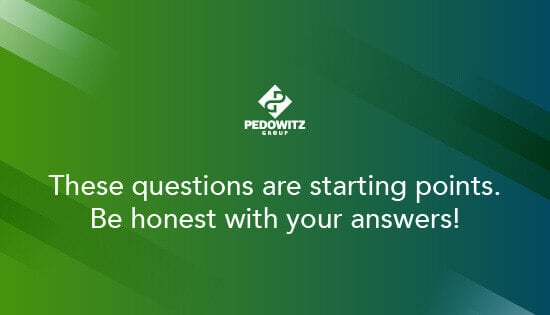
These can be applied to individual pieces of content, or to your philosophy as a whole.
Can we have a strong view of users? Or put another way: Does your tech stack allow you to pull together people’s activity into some sort of a cohesive view? Or will it end up being a bunch of anonymous activity?
Can this be repackaged in a nicer way that’ll encourage people to read? It’s entirely possible your ungated content isn’t getting read. Check scroll depth on heatmapping software, Google Analytics data for time on page / engagement metrics, etc. to get a better understanding of it a piece of content truly resonates.
Do people still download a given piece of content? If not, there’s no reason for it to sit there! Re-use it elsewhere, by taking pieces and updating other content, turning it into its own blog (with PDF format available), or something else.
Is my lead management mature? No matter what you do, having engaged prospects in your pipeline is ineffective on your revenue if leads get lost or if sales and marketing aren’t in sync.
How's our content distribution? If you have a well-developed process for getting content to "live" in other places your ideal customer spends time (think forums, Youtube, LinkedIn posts, podcasts, etc.) then you can much more easily adopt an ungating strategy.
Without this, however, you'll likely suffer or need to ramp up paid distribution.
What’s our CTA? And how long’s our sales cycle? If you’re a software-as-a-service company driving product trials, your needs vary greatly from a financial services firm. Same goes for an eCommerce retailer vs. a manufacturer.
What you want prospects to do matters greatly. I’ve noticed companies in the SaaS space adopting some ungated content strategies, and I can see why: They’re trying to get people more engaged and excited about demoing their platform. If the product doesn’t sell, the company fails, and so educating the market (and thus, creating demand) is at a premium.
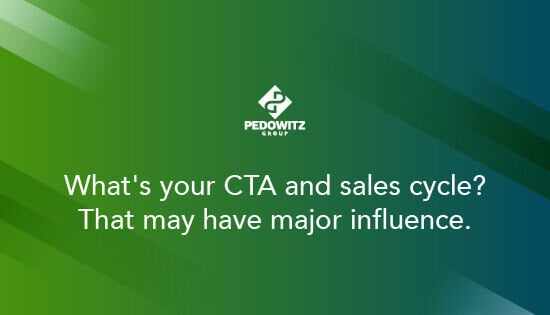
For others, it’s a higher barrier to get that initial phone call or email address with a clear indication of “Hey, let’s do business.” And it might require significantly more investment in the sales cycle.
Knowing these for your company can influence whether gated assets are more important to your pipeline.
Who’s telling you do to something (ungate vs. gated)? …and are they trying to sell you something?
You’ll see it on both sides, but it’s always worth remembering to consider a person’s motives (even if they truly believe in what they're prescribing)!
So, now what?
If you want my biased opinion, listen to this podcast where I talked about this in-depth.
The point of this article is to explore the argument for each side of what can often be a hotly-contested marketing debate. And the best answer for what’s right for you likely lies in your tech stack, ability to scale, and possibly what your core beliefs are about how people in your target audience interact with content.
But no matter which side you’re on, here’s a few takeaways I learned:
Tech matters. So does budget. Knowing what’s possible vs. knowing what’s probable within the scope of your budget matters.
- Are you a company that wants to pursue ABM, but sales and marketing aren’t working terribly well together?
- Do you want to ungate more content, but will not have budget to have the technology to track (or have the time/expertise to act upon what you’re tracking) how people engage?
- Is your organization built in such a way that adopting significantly-different processes and tech will cost more political capital than it’s worth?
These are real questions with real implications.
If you’re considering ungating everything, consider the costs. It’s fair to say more companies gate something on their site, if only because this strategy has been around for a long time vs. intent data being relatively newer.
But to take advantage of what ungating can offer, you need the right infrastructure in place. This might require some additional costs and training - for example, a combination of 6Sense + Seismic + Clearbit + your MAP working together to provide a holistic view of the customer.
Audit your content. No matter if it’s gated or ungated, whatever your customers and prospects are consuming has to be worth their time. That means you should gauge any piece of content through the lens of “is this valuable to my target audience?”
Be honest. Chances are, there’s something that isn’t. And it represents an opportunity to improve what you’re offering.
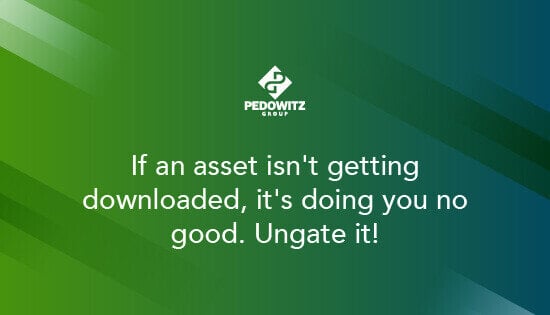
Look at your analytics in various platforms to see what resonates on your website, through paid ads, in emails, and even what’s seen most often in closed-won deals (where applicable).
Every touchpoint matters. And we, as marketers, must be fanatical about providing on-point interactions no matter how a person finds us.
Both sides have arguments. And lots of passion. Hi, LinkedIn, share this and inspire some conversation? :)
But seriously, I went into this thinking there was a clear winner. And now, I’m far more informed about other ways of marketing (and changes on this very website have been made because of them).
Now that you’re more informed, what changes can / should you make to your content to provide a better experience? If you need help with that, well, you’re in the right place.



